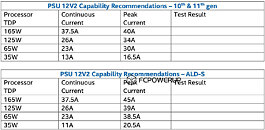Friday, August 6th 2021

Intel Alder Lake ATX12V Peak Current Recommendation is Allegedly Higher Compared to Rocket Lake
Intel's upcoming Alder Lake family of processors, more specifically the desktop ALD-S SKUs, are supposedly going to require a higher peak current for the upcoming processors. In the table provided by the Chinese tech media outlet, FCPOWERUP, we are seeing that ALD-S processors have different power requirements for the ATX12V rails on their power supplies. The listed table shows the previous generation of Intel processors, the 10th and 11th generation, as available in 165 Watt variants. Even though there are no 165 Watt Comet Lake and Rocket Lake SKUs, this is only a placeholder for their PSU recommendations in case those SKUs were to be released.
According to the table, the peak current recommendation for the upcoming Alder Lake is higher at least 5 Amps across all SKUs. The 165 Watt SKUs have the requirement of 45 Amps (compared to the 40 A of Comet Lake and Rocket Lake), while the 125 Watt SKUs require 39 Amps, which is higher than the previous 34 Amp requirement. For 65 Watt models, the new peak recommendation is 38.5 Amps, a jump from the previous 30 Amp choice. The lowest rated 35 Watt SKUs are recommended to use 20.5 A, while the previous generations used 16.5 A current. It should be noted that the continuous rating has not been changed (new generation 35 Watt models actually use less current), which indicates that Alder Lake could have higher peak usages of power, meaning that PSU choice should be made with a 50-100 Watt higher rating.
Sources:
FCPOWERUP (Weibo), via VideoCardz
According to the table, the peak current recommendation for the upcoming Alder Lake is higher at least 5 Amps across all SKUs. The 165 Watt SKUs have the requirement of 45 Amps (compared to the 40 A of Comet Lake and Rocket Lake), while the 125 Watt SKUs require 39 Amps, which is higher than the previous 34 Amp requirement. For 65 Watt models, the new peak recommendation is 38.5 Amps, a jump from the previous 30 Amp choice. The lowest rated 35 Watt SKUs are recommended to use 20.5 A, while the previous generations used 16.5 A current. It should be noted that the continuous rating has not been changed (new generation 35 Watt models actually use less current), which indicates that Alder Lake could have higher peak usages of power, meaning that PSU choice should be made with a 50-100 Watt higher rating.

17 Comments on Intel Alder Lake ATX12V Peak Current Recommendation is Allegedly Higher Compared to Rocket Lake
Edit:
Also, what is the context of this table? It looks like a system-wide power recommendation, think similar to Nvidia/AMD PSU wattage recommendations, although in this case probably for system integrators or OEMs.
For example with a 65W TDP CPU - 276W sustained and peak at 360W or now 462W? This is even beyond what Intel's CPUs consume when unlimited.
Still those peaks could alter the PSU choice.
Intel may have found a way to do things differently from 14nm+++ to 10nmSF, now Intel7 process with a little less voltage but more Amps.
The 12V is not directly related to the 45A here, just because 12V x 45A = 540W wich is no number directly tied to anything CPU related.
Would be very interesting to have numbers from a similar document but related to TigerLake Amps.
Unless you think 200W+ to a single core is feasible.
www.thefpsreview.com/2021/07/28/motherboard-manufacturers-balk-at-intels-new-atx12vo-power-standard-alder-lake-z690-motherboards-to-retain-24-pin-connectors/
All hail the 300W monster of deficiency....and inefficiency
By example, if you have a 300w gfx card and a 850w power supply with few devices, there are already enough power for the spike.
But if you have a gfx card that pump 450+ watts and you get the top end CPU, a 850w powersupply might cause problem in some scenario.
The nature of boosting (increasing the power consumption shortly to increase frequency) is not news, but intel look like they want to go even more savage on that front.
I mean we already have a CPU clock limit at around 4 to 5Ghz.
This seems to indicate that Intel's processors have an "instantaneous power draw", requiring the PSUs to be more carefully built to handle these massive spikes